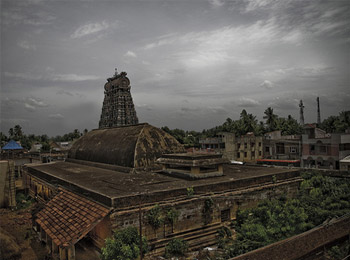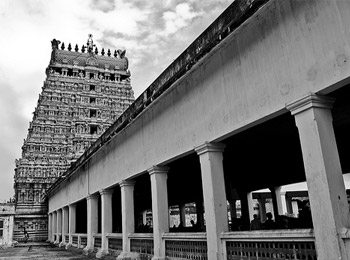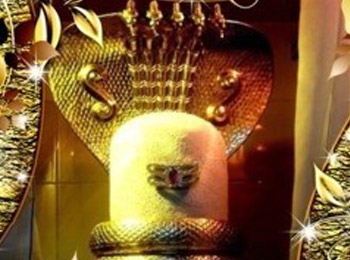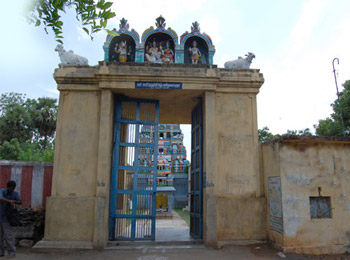- Shiva
Sri Amirthakadeswarar Temple
- Thirukadayur,Tamil Nadu
- View on map
- Tell us about this temple
Overview
The temple of Amritaghateswarar Abhirami is dedicated to the god Shiva in his manifestation as Kalasamhara Moorthy and his wife Parvati in her form as Abhirami (Sanskrit: "Lovely One"). This temple is located in Thirukkadaiyur (Thirukadavur), 21 km East of Mayiladuthurai, Tamil Nadu in India. This temple is mainly connected with Shiva saving his devotee Markendeya from death and the tale of Saint Abirami Pattar, whose real name is Subramanian, a devotee of the presiding goddess.
It is one of the 275 Paadal Petra Sthalams, where three of the most illustrious Nayanars (Saivite Saints), Appar, Suntharar and Tirugnana Sambhandar have sung the glories of this deities. It is 47th paadal perta sthalams.
Main dieties

Meenakshi Sundareswar Temple is dedicated to Sundareswar (form of Lord Shiva) and Meenakshi (form of Goddess Parvati). The term "Sundareswar" suggests "the beautiful lord" and "Meenakshi" means "the fish-eyed goddess". As per the Hindu folklore, Madurai is the same city where Lord Sundareswar (Shiva) appeared to marry Goddess Meenakshi (Parvati). Meenakshi Temple is regarded as one of the most sacred places of Parvati, other being Kamakshi at Kanchipuram, Akilandeswari at Thiruvanaikaval and Vishalakshi at Varanasi.
At the center of the sanctum sanctorum, the shrine of Shiva embraces the site. It is a famous image of Nataraja (Dancing form of Lord Shiva) on a massive silver altar. The shrine is also known as Velli Ambalam (Silver abode). In the proximity, there is a shrine dedicated to Lord Ganesha. Known as Mukuruny Vinayakar, the temple adores the idol that was found during the excavation made in Temple Lake. On the left side of Shiva, the shrine of Goddess Meenakshi appears enchanting with quite less ornamentation.
About The Temple

There are very few temples which are known for the Lord and his Consort and Thirukkadaiyur is one amongst them. The Amirthakadeshwarar Abirami Temple of Thirukadaiyur is associated with the legends of Markandeya and Abirami Battar. The temple is a grand representation of Chola architecture. It spreads over 11 acres, and consists of five Prakarams, magnificent temple towers, huge and expansive Mandapams. Though the particulars of the king who consecrated the temple is not established, according to the inscriptions in the temple it has been in existence during the era of Raja Raja Cholan, since early 11th century.
Based on the inscriptions seen here, it is inferred that the stone base of the central shrine was in existence even during period of Raja Raja Cholan (early 11th century). It was during the period of Kulottunga Chola I (1075 - 1120) that the brick walls of the temple were replaced with stonewalls and the Mandapam in the front was constructed. The Rajagopuram is replete with images made of mortar, depicting the legends associated with the temple. This is the Eighth Veeratanam among the Eight Veeratanam (Avatharams) of Lord Shiva..
About the Deity

The presiding deity of this temple is Sri Amirdhagadeswarar Swamy. He is accompanied by his consort, Sri Abirami Ammai. The other Deities tahe grace the are: Kala Samhar Moorthy, Kallavaaranam Pillaiyar, Yaman, Markandeyar, Nataraja, Kungiliakkalaya Nayanar. In a shrine, Mother Parvathi appears with Lord Muruga in Her right lap, praised as Guhambika. Lord Kalla Varana Pillayar appears with the nectar pot in his hand. Lord Brahmma, Sages Agasthya, Pulasthya, Serpent Vasuki, Mother Durga had worshipped Lord in this temple. The procession deity is Lord Kala Samhara Murthy. Those looking to have a long life throng the temple to seek the blessings of Sri Amirdhagadeswarar.
Legend and stories
Lord Maha Vishnu desired to perform Shiva Puja before serving the nectar to Devas. According to rules Shiva Puja should be performed along with Ambica. Lord Mahavishnu took off all his adornments which was to represent Mother Ambica. Mother Ambica rose from these adornments. After finishing the Shiva Puja, he served the nectar to Devas. It is assumed that the ornament of Lord Vishnu is where Mother Mahalakshmi resides. As Ambica-Abirami was born of the jewels, Vishnu is praised as the Mother of Ambica also, though generally she is widely extolled as the younger sister (Yoga Maya) of Lord Mahavishnu. The wonderful compassion of Mother Abhirami is obvious from an event that saved her devotee from capital punishment..
While in deep prayer in the temple with his mind set on the beautiful face of Abirami, her ardent devotee Subramanian, when enquired about the Thithi of the day by king Sarfoji, said it was a full moon day though it happened to be a new moon day. The king said that if he failed to prove that it was full moon day, he would be put to death.
Unfazed by the directive of the king, his faith completely at the feet of Mother Abirami, Subramaniam began singing her glory in 100 verses in Andhadhi, a poetic style. Andhadhi – first and last – that is the last word of the previous verse will be the first word in the next verse. This is usually sung in 100 verses. The entire people along with King Saraboji assembled to witness this event and were waiting to see whether Subramaniam would be able to fulfill the King Saraboji’s order. When Subramaniam was singing the 79th verse, Mother Abhirami threw her Thadanga – ear rings in the air which shone as a full moon. This event is till to date celebrated in the temple on the New Moon day of Tamil Thai month – January-February. Mother Abirami grants darshan from her palanquin decked with flowers. These hundred songs are now celebrated as Abhirami Andhadhi chanted by devotees as a daily routine. On this festival day, this is chanted with an Arati for each song. When the 79th song is chanted a powerful electric lamp is switched on signifying the full moon appearing from Her Thadangas-ear rings. Devotees crowd is naturally enormous on this day.
Sage Mrigandu and his wife Maruthuvathi were praying to Lord Shiva for a child. The sage performed severe penance. Lord said that the sage couple would have a son with all wisdom and noble characters but his life would be too short spanning just 16 years. He was named Markandeya. When he reached the age of 16, his parents were depressed. Knowing the problem, Markandeya went for pilgrimage to all Shiva Sthalas. And finally came to Tirukadayur. This was the 108th temple of his pilgrimage. It happened to his day of calling. While he was praying to Lord, Yama, the god of death, directly came there to take his life. Seeing Yama, Markandeya embraced Lord Amirtha Kadeswara with all his might. When Yama threw his rope on Markandeya, it fell and covered Lord also, who in all fury hit him and destroyed him with His trident. Hence the Lord came to be known as Kalasamhara moorthy. Turning to Markandeya, Lord said that he would ever be 16 only and will be a chiranjeevi, one without death. Markandeya brought Ganga water for his Shiva puja. To facilitate his Shiva Puja, Lord made Ganga spring in a well near the Brahmmapureeswarar temple adjacent to Thirukadavur cremation ground. Markandeya was happy to use this water for the abishek of Lord. Even today, this is the water used for abishek in the temple. Devotees are not allowed to bathe in this spring. The Ganga spring appeared on the Aswathi star day in Thai month (January-February). Devotees are allowed to bathe here only on this day each year.
It is said that a jasmine flower belonging to Pinjilam variety also came along the Ganga spring which blossoms throughout the year used only for the archana of Lord. Others cannot use it. It is also said that archana with one flower is equal to an archana with 1008 flowers.
As Yama was no more, there was no one to manage the end of creations in the earth. Mother Earth could not bear the accumulated weight of beings living long without any end. She prayed to Lord Shiva and communicated her difficulty. Lord shed his anger and brought back Yama to life in this sacred bhoomi of Thirukadayoor. Lord is praised as Kala Samhara Murthy. His left leg is on Adishesha the celestial serpent. He is holding His trident on Yama beneath. Nearby is Gundodhara dragging Yama with a rope. But Yama is not visible during darshan. During the puja time, when the peeta is opened, Yama is visible. The darshan of Lord with trident is called Samhara style and that with Yama is called Anugraha style. Devotees can worship Lord Amirthakadeswarar in both forms. Mother Balambika as a little girl appears with two hands with Mothers Lakshmi and Saraswathi close by.
Similar to the Akash Rahasya – holy secret – in Chidambaram, in the Thirukadayoor temple there is a Yantra in the right wall of the shrine called Tirukadayur Rahasyam. While worshipping Lord Papahareswarar and the presiding Lord, people also worship this yantra for longevity.
Yama appears in the shrine of Kalasamhara Murthy in a worshipping posture with his buffalo vahan nearby.Poornabishekam for those have completed 100 years, Kanakabishekam after completing 90 years, Sathabishekam on completion of 80 years, Beemaratha Shanthi (70 years) and Manivizha (60 years) are performed for long life with Ayush Homam. During such celebrations 16 Kalasas and nine varieties of corns and pulses are placed summoning the presence of nine planets. After the rituals, the water in the Kalasas-pots is poured on the couple as Prasad abishek by their relatives. This is said to wash away any sin attached with such aged ones. Then they have to worship Lord Brahma Pureeswarar whose temple is near the Thirukadvur cremation ground. For this celebration no day, date and auspicious time are required to be followed as they take place in the presence of Lord in the temple.
The mark of the rope thrown around Markandeya and the Linga, is still on the Linga which would be visible during abishek times. The evening pujas in the temple begin with Lord Adhi Vilva Vana Nathar. There is a cave tunnel used by Markandeya to bring the Ganga water for Lord’s abishka.
Devotees, according to tradition, begin their worship with Lord Papa Kareswarar, worshipped by sage Agasthya and Lord Punya Kareswarar worshipped by Sage Pulasthya and proceed to other sannidhis (shrines). There is a seperate shrine for Lord Punya Kareswarar. Papa Kareswara temple is opposite this shrine with holes on the wall. The scar caused by Yama’s rope is visible on the Shivalinga. The idol of Lord Kalasamharamurthi is made of copper expressing all anger with trident upside down on Yama, hitting him by the right leg and facing south.
Devotees, according to tradition, begin their worship with Lord Papa Kareswarar, worshipped by sage Agasthya and Lord Punya Kareswarar worshipped by Sage Pulasthya and proceed to other sannidhis (shrines). There is a seperate shrine for Lord Punya Kareswarar. Papa Kareswara temple is opposite this shrine with holes on the wall.The scar caused by Yama’s rope is visible on the Shivalinga. The idol of Lord Kalasamharamurthi is made of copper expressing all anger with trident upside down on Yama, hitting him by the right leg and facing south.
Temple History
Lord Brahma, one among the trinities, who performs the task of creation, once went to Kailash to receive the Gnana Upadesa (wisdom learning). Lord Shiva gave the seeds of Vilwa tree to Brahma and instructed him to sow them in various places of the earth. Where the seed germinated within an hour into a tree was treated as the venue of teaching by Lord Shiva. One such place was Thirukadayur. Shiva the teacher of Brahma was henceforth worshipped as Adhi Vilwavana Nather in the temple having a separate shrine of his own.
The Devan began to consume the nectar without offering prayers to Lord Vinayaka who simply hid the pot. They realized their folly and prayed to Vinayaka, got it from Him and placed it in this Thirudayur for Shiva Puja. When opened it was Shiva Linga. As Lord Shiva appeared here as a Swayamnu Linga from the Amirtha-nectar pot He is worshipped as Amirtha Kadeswarar.
Festivals
18 day Yama Samharam in the Tamil month of Chithirai – April-May commencing on the Magam Star day with Lord’s procession each day, Kalasamhara Murthy darshan on the 6th day; Karthikai Monday abishek with 1008 conches; Purattasi Navarathri in September-October; one day Margazhi Vishi Padam festival in December-January; Aadi Pooram in July-August; Aipasi Skanda Sasti in October-November; Maha Shivrathri in February-March and Panguni Uthiram in March-April are the festivals celebrated in the temple. On the New Moon day of Thai month – January-February, the temple follows a devotional practice of Andhadhi Parayanam and worshipping the Moon. Devotees throng the temple will be huge on Pradosha days. Other general festivals as Deepavali, Pongal, Tamil and English New Year days are also observed in the temple with special abisheks and pujas.
Pooja Details
Six times a day
Temple Timing
The temple is open form 06:00 am to 01:00 pm and from 04:00 pm to 09:00 pm.
Thanks giving
Those seeking wedding boon offer Wedding garlands. Some offer their child in adoption for child boon and perform Rudrabishekam. Those suffering from diseases of serous nature, perform Conch Abishek (Sangabishekam) for cure. Patients facing heart related problems conduct the Mrutyunjaya Homa (conquering the God of Death). Many devotees with deep faith had survived even serious heart attacks. Devotees perform abishek to Mother Abhirami with sandal, rice flour, cosmetic powders, oil, milk, curd, green coconut, Panchamirtham, lime juice, honey. Women scared of the safety of their Mangal Sutra (fear of widowhood) use to place a new mangal sutra at the feet of Ambika wear it, leaving the old one at Her feet. Many undertake Annadhanam-feeding. Many contribute liberally for the renovation of the temple. They also offer Sari to Mother.
Rare facts
Presiding Lord in the temple is a Swayambumurthy. Of the Atta Veera Sthalas, Thirukadayur is one where Yama was hit by Lord Shiva. Though there is only one Linga in the sanctum sanctorum, a close look will show another Linga too in shady form. The scar caused by the Yama’s rope is visible on the Linga only during abishek times.
Significance
Majority of the devotees perform their birth days, Sashti Aptha Poorthi (completing 60 years) Ukra Radha Shanti (completing 59 years) Beemaradha Shanti (completing 70 years),Sathabishekam (completing 80 years) seeking Lord and Mother blessings. Devotees completing their 60 years for celebrating their Sashti Aptha Poorthi called Mani Vizha in Tamil, include not only those from Tamilnadu but from states of India and countries of the world. People celebrate their 50th wedding day and for relief from adverse aspects of planets. Mother Abhirami is all merciful and powerful. She grants boons of prosperity, wedding, child and distinction in academic pursuits.People worship Lord Kalasamhara Murthy for longevity. Many pray to Lord Amirthaladeswarar for mental peace and relief from confusions. They also pray for job opportunities and profits in trade and industry.
Accessibility
Airport
There are no regular flights from other major cities of the country to thirukadaiyur. Nearest airport is pondicherry airport. Thirukadaiyur is 125 Km away from Civil Airport, Thiruchirappalli, Tamil Nadu.
Railways
Thirukadaiyur does not have an train station. Nearest option is Karaikal(85 km).
Road
You can easily get regular buses to Thirukadaiyur from other major cities of the country.
Temple Address
Sri AmirdhagadeswararTemple,
Thirukadaiyur (Po.), Tharangakbadi (Tk.), Nagappattinam (Dt).
Significance
Devotees visit this temple to seek fulfillment of the following:-
- To celebrate sasthiaptha purthi (61st birthday)
- ukratha shanthi
- bheemaratha shanthi (70th birthday)
- sadhabishekam (80th birthday)
- birth star days and ayush homan (prayer for longevity)
- To pray on the 50th anniversary of their wedding days
Shlokas
Kailaasarana Shiva Chandramouli Phaneendra Maathaa Mukutee Zalaalee Kaarunya Sindhu Bhava Dukha Haaree Thujaveena Shambho Maja Kona Taaree
Meaning -Oh Lord Shiva who is seated on Mount Kailash, where the moon decorates his forehead and the king of serpents crown his head, who is merciful and removes delusion, You alone can protect me. I surrender to thee.
Aum Trayambakam Yajaamahey Sugandhim Pusti Vardhanam Urvaarukamiva Bandhanaath Mrutyor Muksheeya Maamritaat
Meaning -We worship the fragrant Lord Shiva, who has 3 eyes and who cultivates all beings. May He free me from death, for immortality, as even a cucumber is separated from its bond with the vine.
Timings
5:30 a.m. - 1 p.m.3:00 p.m. - 8:30 p.m.
